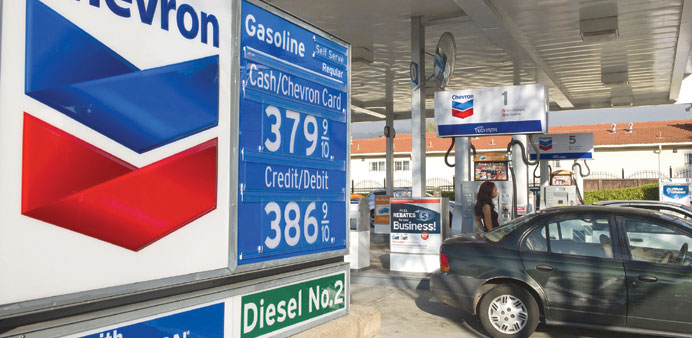A customer pumps gasoline at a Chevron Corp gas station in Berkeley, California. One of the company’s biggest bets on natural gas has suffered more delays and budget overruns, as cost pressures including a stubbornly high local currency continue to plague companies operating in Australia.
Dow Jones
Oakland
One of Chevron Corp’s (CVX) biggest bets on natural gas has suffered more delays and budget overruns, as cost pressures including a stubbornly high local currency continue to plague companies operating inAustralia.
The estimated cost of Chevron’s massive Gorgon development, which the company started building in 2009 to feed Asia’s growing thirst for cleaner-burning fuels, has risen by $2bn to $54bn, Chevron, the second-biggest US oil company by output, said in a statement.
The first cargos of liquefied natural gas, or LNG, won’t start being shipped from the project at Barrow Island in Western Australia state until “mid-2015.” Previous guidance had been for early 2015.
Chevron’s announcement came just a day after General Motors Co (GM) said it would cease manufacturing in Australia by 2017, citing pressures from the nation’s strong currency and intense competition in the local automobile market. A strong Australian dollar makes it cheaper for rivals to import competing products from overseas, while pushing up costs for locally sourced labour and equipment.
Despite falling significantly in recent months, the Aussie remains at $0.90 due to ongoing demand for the country’s mineral exports from China and relatively high interest rates compared to the US, Japan and Europe.
Chevron had already cited the strong Australian dollar as a key driver of a previous blowout at Gorgon, which was originally supposed to cost $39bn and start shipping its first cargos next year. Three rival LNG projects in Queensland state backed by ConocoPhillips (COP), Total SA (TOT) and BG Group PLC (BG.LN) have also experienced massive budget overruns in recent years. Exxon Mobil Corp (XOM) and Royal Dutch Shell PLC (RDSA) are shareholders in Gorgon.
Chevron said the project’s economics remain attractive, following a sharp increase in oil prices since construction began. Gorgon’s Asian customers are locked into contracts typically lasting 20 years that are linked to the fluctuating price of oil.
“We continue to make steady progress against key project milestones and are applying lessons learned to our Wheatstone development,” Chevron Vice Chairman George Kirkland said in the statement.
Wheatstone, estimated to cost $29bn, is the company’s second LNG development in Australia. It’s around 25% complete, while Gorgon is around 75% complete.
“These LNG developments are two of our most important future legacy assets, representing approximately 400,000 barrels a day of net production at full capacity,” Kirkland said.
Gorgon marks Chevron’s first attempt to build an LNG project, which are technically complex and expensive developments that regularly suffer setbacks. It hasn’t been helped by Australia’s relatively small pool of skilled labour, forcing it to offer attractive pay and conditions to lure workers, often to remote locations with unpleasant weather and few social amenities.
Barrow Island is a Class-A nature reserve and Gorgon’s approval was subject to it meeting a string of environmental conditions, including the introduction of measures to protect rare species of turtles and birds.

